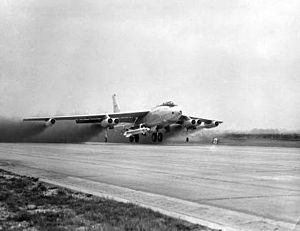WS-199
| WS-199 | |
|---|---|

A B-47 takes off carrying a Bold Orion ALBM, developed under WS-199
|
|
| Type | Experimental missile program |
| Place of origin |
|
| Service history | |
| In service | 1957-1959 |
| Used by | Strategic Air Command |
| Production history | |
| Variants | Bold Orion, High Virgo, Alpha Draco |
Weapons System 199 (WS-199) was a weapons development program conducted by the United States Air Force to research and develop new strategic weapons systems for Strategic Air Command. Two air-launched and one ground-launched vehicles were developed as part of the program; while none entered production, they assisted in the development of both the GAM-87 Skybolt air-launched ballistic missile and that of re-entry vehicles for ballistic missiles.
The US Navy began their Polaris missile project in December 1956, and this program presented serious problems for the Air Force's own missile developments. The Air Force intercontinental ballistic missiles (ICBM's) were liquid fueled and required considerable time to fuel and spin up their inertial platforms before launch, during which time they were open to air attack. This meant that a Soviet sneak attack by bombers on the ICBM bases, combined with using their own ICBMs against Strategic Air Command's bomber bases, could significantly damage the Air Force's strike capabilities.
In comparison, Polaris could be launched from practically anywhere in huge areas of the Atlantic and Pacific, and was essentially immune to attack. The Navy developed a policy known as "survivable deterrent force" of about 600 warheads, which they felt would deter any Soviet attack under any circumstances. As they laid plans to build the Polaris submarine fleet needed to carry these missiles, the Air Force was left in the position of potentially being cut out of the deterrence role. This was most forcibly pointed out in an internally circulated document entitled "The Problem of Polaris".
The response was two-fold. One was WS-199, which explored various options to make the Air Force's own missiles as immune as the Navy's. The primary method was the air-launched missile, which would be kept on station close to the Soviet Union but outside their defensive range, and able to be launched at a moment's notice. They also explored ways to extend the range of ground-launched missiles, so that small mobile missiles might be able to carry out attacks from the United States without being subject to attack. Other options, not part of WS-199, was an active defense using the LIM-49 Nike Zeus and its follow-ons, and rail-based launchers.
...
Wikipedia
